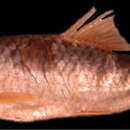Diagnostic Description
provided by Fishbase
Diagnosis: D IV, 9-10; A 2-3/6; lateral line scales (29) 30-33; circumpeduncular scales 12 or 14. Upper profile convex, lower one almost straight; Body depth 24.5-29.8 % of SL. Snout narrowed anteriorly, sometimes almost pointed; in large-sized specimens it is about twice the length of the eye diameter. Lower lip smooth and without median lobe. The anterior pair of barbels is absent in most specimens, may be present but rudimentary (Ref. 57642).
- Recorder
- Estelita Emily Capuli
Diseases and Parasites
provided by Fishbase
Bothriocephalus Infestation 2. Parasitic infestations (protozoa, worms, etc.)
Diseases and Parasites
provided by Fishbase
Yellow Grub. Parasitic infestations (protozoa, worms, etc.)
Morphology
provided by Fishbase
Dorsal spines (total): 4; Dorsal soft rays (total): 910
- Recorder
- Estelita Emily Capuli
Trophic Strategy
provided by Fishbase
Lives in small and wide streams and in lakes and ponds. Feeds on invertebrates and small fish.
- Recorder
- Drina Sta. Iglesia
Biology
provided by Fishbase
Lives in small and wide streams and in lakes and ponds. Feeds on invertebrates and small fish. Spawns in June to September in shallow water over gravel.
Jordan himri
provided by wikipedia EN
- license
- cc-by-sa-3.0
- copyright
- Wikipedia authors and editors
Jordan himri: Brief Summary
provided by wikipedia EN
The Jordan himri (Carasobarbus canis) is a ray-finned fish species in the family Cyprinidae.
It is found in Israel, Jordan, and Syria. Its natural habitats are rivers and freshwater lakes. It is not considered a threatened species by the IUCN.
- license
- cc-by-sa-3.0
- copyright
- Wikipedia authors and editors
Description
provided by Zookeys
The body is low. A nuchal hump is present in adults but absent in juveniles. The largest body depth is at the origin of the dorsal fin. The head is long, rather low and fairly narrow with straight dorsal and convex ventral profile (Figs 8, 9). The head length approximately equals the body depth. The mouth is terminal or slightly subterminal. Two pairs of barbels are present (Table 2). The lips are smooth and thin (Fig. 3). The eyes are at the end of the anterior half of the head. The morphometric characters are summarised in Table 1.
Pectoral, ventral, dorsal and anal fins are comparatively short (Table 1). The dorsal fin usually has four unbranched and 10 branched rays (Table 3). The last unbranched ray is ossified and its distal part is flexible. It is usually markedly shorter than the head (Fig. 4). The anal fin usually has three unbranched and six branched fin rays (Table 4).
There are 29 to 35 scales in the lateral line (Table 5), usually 4.5 or 5.5 scales above the lateral line (Table 6), usually 4.5 scales below the lateral line (Table 7) and usually 12 scales around the least circumference of the caudal peduncle (Table 8). The scales are shown in Fig. 5.
The pharyngeal teeth count is 2.3.5-5.3.2 in 23 specimens, 2.3.3-5.3.2 in one specimen, 2.3.5- in one specimen and -5.3.2 in one specimen. The pharyngeal teeth are hooked at their tips (Fig. 6).
Live specimens are silvery to bronze coloured. The posterior third of the body and the fins are distinctly yellow in many specimens (Fig. 9). Ethanol-preserved specimens are brownish yellow and the back is only slightly darker than the rest of the body (Fig. 8). The fins are brownish yellow. Juveniles have a dark lateral spot on the caudal peduncle.
Carasobarbus canis differs from Carasobarbus apoensis and Carasobarbus luteus in having two pairs of barbels vs. one, from Carasobarbus kosswigi and Carasobarbus sublimus in having a crescent-shaped lower lip without median lobe vs. a spatulate lower lip with median lobe, from Carasobarbus exulatus in modally having 10 branched dorsal-fin rays vs. nine and from Carasobarbus chantrei, Carasobarbus fritschii and Carasobarbus harterti in modally having 10 scales around the least circumference of the caudal peduncle vs. 14 or 16.
- license
- cc-by-3.0
- copyright
- Kai Borkenhagen, Friedhelm Krupp
- bibliographic citation
- Borkenhagen K, Krupp F (2013) Taxonomic revision of the genus Carasobarbus Karaman, 1971 (Actinopterygii, Cyprinidae) ZooKeys 339: 1–53
- author
- Kai Borkenhagen
- author
- Friedhelm Krupp
Distribution
provided by Zookeys
Carasobarbus canis occurs in the Jordan River system (Fig. 7). There are only few records from coastal rivers of the Mediterranean Sea (Naẖal Na‘aman and Naẖal Yarqon). A recent treatment of the inland water fish communities of Israel does not report Carasobarbus canis from coastal rivers (Goren and Ortal 1999). The population in the Azraq Oasis was introduced by humans (Krupp and Schneider 1989). Since the year 2000 this species was not found in Azraq (Hamidan 2004) and the population may have disappeared due to drought. Records from the Tigris-Euphrates system (Banister 1980) are based on misidentifications.
- license
- cc-by-3.0
- copyright
- Kai Borkenhagen, Friedhelm Krupp
- bibliographic citation
- Borkenhagen K, Krupp F (2013) Taxonomic revision of the genus Carasobarbus Karaman, 1971 (Actinopterygii, Cyprinidae) ZooKeys 339: 1–53
- author
- Kai Borkenhagen
- author
- Friedhelm Krupp

